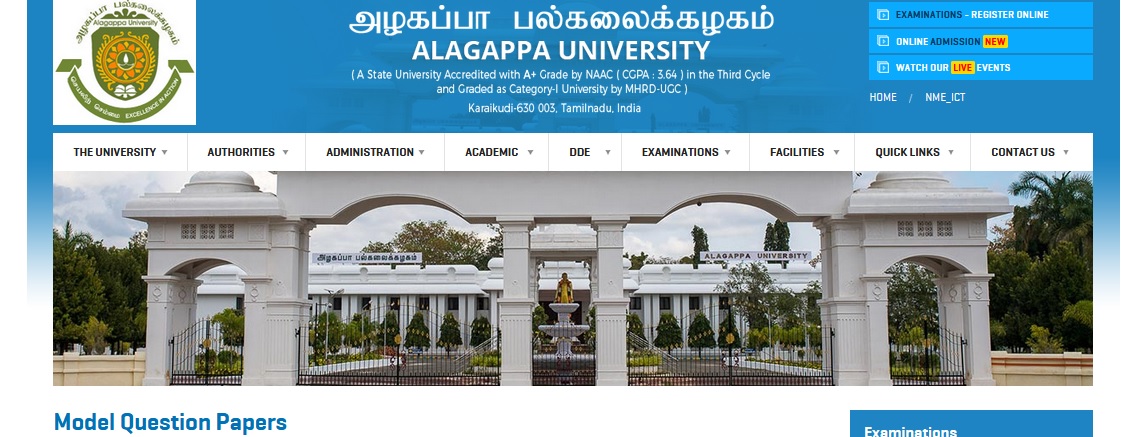Mathematical Foundation For Computer Science B.Sc Model Question Papers : alagappauniversity.ac.in
Name of the University : Alagappa University
Degree : B.Sc
Department : Computer Science
Subject Code/Name : Mathematical Foundation For Computer Science
Semester : I
Document Type : Model Question Papers
Website : alagappauniversity.ac.in
Download Model/Sample Question Paper : Nov 2010 : https://www.pdfquestion.in/uploads/alagappauniversity.ac.in/4009.-B.Sc.%20Computer%20Science%20%5BNon-CBCS%5D.pdf
Alagappa Mathematical Foundation Question Paper
Time : 3 Hours Maximum : 100 Marks
Section – A :
1. Define Contradiction.
Related / Similar Question Paper : Alagappa University B.Sc Analytical Geometry 3D Question Paper
2. Construct the truth table for P – Q.
3. Obtain the PDNF of P – Q .
4. Give the rules of Inference.
5. Define the degree of the vertices in a graph.
6. Give an example of subgraphs.
7. Define Hamiltonian graph.
8. When do you say that a tree is spanning tree –
9. State distributive lattice.
10. Give an example of Equivalence relation.
11. State and prove DeMorgan’s Law.
12. Show that (P- Q)- ( P – Q) is a tautology.
13. Obtain CNF of the following :
14. Prove that R – S can be derived from the premises

15. Show that in any graph there is an even number
16. Explain cut set and cutvertices with an example.
17. For any a, b, in A.prove that (i) a – (a – b) – a ;
18. Obtain the PDNF of the following :(i) P- ((P- Q) – ( Q – P))
19. Show that :(x) ( p (x)- Q (x) – (x) (Q (x)- R(x)- (x) ( p(x)- R (x))
20. Prove that a connected graph G is Eulerian if and only if every vertex of G has even degree.
21. Explain Dijkstra’s Algorithm and find a shortest path from a to z in G using Dijkstra’s Algorithm.
22. Show that any connected graph with ‘n’ vertices and (n – 1) edges in a tree.
23. Define spanning tree. Prove that every connected graph has at least one spanning tree.
24. Prove that in a Lattice both the join and meet operations are associative.
25. Show that in a distributive lattice, if an element has a complement then this complement is unique.
Programming in C
1. ———— bytes are required for storing a double variable.
2. State the difference between get C () and getchar () in C.
3. ———— function finds the square root of a value in C.
4. & Operator is used to perform logical AND operation in C.
5. A ———— is a variable that contains the address of a variable in C.
6. A sequence of characters in double quotes is called as ————.
7. ‘Size of ’ is a unary operator in C.
8. How will you transfer a complete structure to afunction –
9. Name the two categories of stream – oriented data files.
10. Printf ( ) performs unformatted write operation in C.
11. List out the various data types in C. Give examples.
12. Explain the uses of the following in C :(a) Exit. (b) Continue.
13. State the use of the following in C :.
14. Write a program in C to find whether the given number
15. Explain with an example how you will pass structures to functions.
16. Discuss about pointers to structures.
17. Explain about the command line parameters in C.
18. Describe the various types of operators in C.
19. Explain with an example : (a) do-while loop.
20. Define recursion. Write a program in C using recursion.
21. How will you pass arguments to a function ? Give an example.
22. Write a program in C to declare a two – dimensional array, also include the code to accept and display its values.
23. Describe dynamic memory allocation. Write a program in C to create a linked list with each node containing two fields i.e., rollno and name.
24. Write a program in C to define structure with the following fields : empno., name, department, designation and salary. Read and display data using pointer to structures.
25. Explain in detail the steps involved in file operations.
B.Sc. Degree Examination, November 2010 :
Probability & Statistics
(Non-CBCS—2004 onwards)
Time : 3 Hours
Maximum : 100 Marks
Part – A (10 × 1 = 10)
Answer all questions.
1. Write down the relation between mean, median and mode.
2. Define Kurtosis.
3. Give the formula of Standard Deviation.
4. Write the formula of Rank Correlation.
5. List the equations of Regression.
6. State the formula of Lagranges method.
7. Differentiate interpolation and entrapolation.
8. Give one example of discrete random variable.
9. Define m.g.f.
10. Find Mean of Poisson distribution.